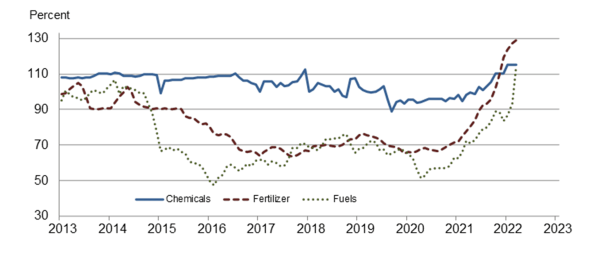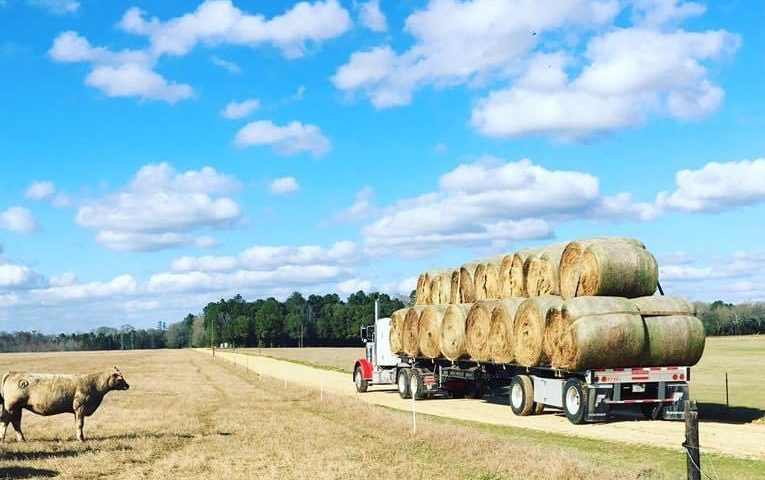Farm Management

Hay production is one of the largest and most economically significant agricultural enterprises in Alabama with 700,000 acres farmed producing 2,170,000 tons of product valued at $217,000,000 (USDA-NASS). Hay is used as livestock feed for cattle, horses, and small ruminants. Hay can also be used as bedding, mulch, decoration, and include numerous other uses. Price ranges for hay sales often depend on variety baled, the size and structure of bales, and the quality of the bale. There is little public information on the price of hay, and when combined with the wide variances of size and quality producers and consumers are left to question the true value of hay they seek to sell or purchase. This ultimately leaves both parties searching for a reasonable price point that allows the hay producer and the livestock producer the opportunity to achieve a profit or minimize cost.

Paid indexes by non-farm origin and month, chemicals, fertilizer, and fuels. United States: 2011=100. Source: https://www.nass.usda.gov/Charts_and_Maps/Agricultural_Prices/received.php
Increasing Input Prices
As shown in Figure 1, prices of inputs used in agricultural production have increased in 2022 throughout the United States. Fertilizer, chemical, and fuel costs have increased significantly, leading to even more questions as to how producers should price hay to their hay consumers (and likewise what livestock producers should be willing to pay). Based on prices published in Profit Profiles, we compare estimated fertilizer costs in Alabama in Table 1. The amount of nitrogen, phosphate, and potash used to produce a round bale of bermudagrass hay has increased 95% from May 2021 to May 2022. To consider how to respond to these price increases, we present pricing strategies from the perspective of the hay producer.
Table 1. Alabama Fertilizer Costs per 1000-pound Bale
| Inputs | May 2021 | May 2022 | Percent Increase |
|---|---|---|---|
| Nitrogen | $18.75 | $36.50 | 95% |
| Phosphate | $3.04 | $5.13 | 69% |
| Potash | $6.50 | $13.67 | 110% |
| Total | $28.29 | $55.30 | 95% |
Know Cost of Production
Hay producers must know their cost of production, including both fixed and variable costs. They must also determine the minimum profit margin they are willing to accept for their product. Both cost of production and acceptable profit margin will vary greatly among producers and careful consideration should be given to both in order to ensure profitability and sustainability.
Cost of production can be broken down into two segments: variable costs and fixed costs. Variable costs are the costs that change as our production changes, such as fertilizer. Variable costs only occur if we produce.
For example, even though fertilizer prices are at an all time high, it will not affect a producer’s bottom line if the producer doesn’t fertilize and doesn’t cut hay. However as producers increase production, the amount of nutrients removed from the soil will also increase and therefore the cost of maintaining production and fertility will increase significantly.
Table 2. Fertilizer Nutrients Removed in 6 Tons of Bermudagrass Hay
| Nutrients | Pounds/Acre |
|---|---|
| Nitrogen (N) | 300 |
| Phosphorus (P2O5) | 84 |
| Potassium (K2O) | 252 |
| Calcium (Ca) | 36 |
| Magnesium (Mg) | 27 |
| Sulfur (S) | 27 |
The value of nutrients removed by 6 tons of bermudagrass hay is shown in Table 2. Removing these nutrients would be equivalent to a cost of over $50 in fertilizer at current prices per 1000-pound round bale. This would be more than many livestock producers have historically paid for hay, and this doesn’t include other variable costs that are also well above historical levels such as fuel, wrap, and repair costs.
Table 3. Alabama Variable Cost Per 1000-lb Bale
| Inputs | 2021 | 2022 | Percent Increase |
|---|---|---|---|
| Soil Test | $0.08 | $0.08 | 0% |
| Nitrogen | $18.75 | $36.50 | 95% |
| Phosphate | $3.04 | $5.13 | 69% |
| Potash | $6.50 | $13.67 | 110% |
| Herbicide | $0.57 | $0.62 | 9% |
| Lime | $1.17 | $1.31 | 12% |
| Labor | $7.28 | $7.69 | 6% |
| Land Rent | $1.91 | $2.00 | 5% |
| Tractor & Equipment | $3.65 | $3.95 | 8% |
| Interest on Operating Capital | $0.92 | $0.93 | 1% |
| Total Variable Cost | $43.87 | $71.88 | 64% |
Table 3 illustrates the variable costs for a 1000-pound bale of bermudagrass hay. Based on the ACES Enterprise Budgets for round bale bermudagrass hay, and fertilizer prices reference in Table 1, the variable cost of production has increased 64% from May 2021 to May 2022. While this is driven primarily from the higher fertilizer prices, one can see that all other costs, except the price of the soil test, has increased. We estimate the 2022 variable cost of production to be $71.88 per 1000-pound bale, up from $43.87 in 2021.
Fixed costs on the other hand will occur whether producers are actively farming or not. An easy example of fixed costs would be land taxes and depreciation – both of these happen whether the producer spreads fertilizer, cuts hay, or doesn’t do anything. Producers should take into account all of the equipment, land, tax, insurance and other fixed costs that are often ignored when budgeting costs for hay production. While producers can operate for a short time covering only their variable expenses, they will find sustainability difficult long term without covering their total costs, i.e. variable costs and fixed costs. Failure to budget and price for coverage of fixed costs will ultimately cost producers the ability to grow wealth in their operation.
Consider Profit Margins
There are factors beyond the cost of production that also need to be considered when pricing hay. The profit margin that producers are willing to accept is a necessary consideration. Margins can be a percentage of costs or a dollar value per unit of production and is based on the amount of profit one expects or needs on a given enterprise unit. This will vary significantly by producer and situation. For example, if one’s sole income is based on their hay operation, a margin would need to include a living family wage as well as covering variable and fixed costs. Producers could also assume non-monetary value from their hay operation, such as family bonding time when baling hay or preservation of aesthetic beauty of a family home place. All factors should be considered when producers are calculating their required margin.
Ultimately each producer must assess his own cost of production and his own acceptable profit margin when pricing their hay – and each producer might be different than his neighbor. For example, a large hay producer whose sole income is based on hay sales might have a lower cost per bale. This is because of economy of scale in larger operations achieved by increased production and output with the same equipment. However, larger hay producers may need a higher margin in order to cover their cost of living.
Factors in Pricing: Competition, Customer Relationships, and Supply
While setting a price should first consider the cost of production and profit margin, one must also consider what consumers will be willing to pay. Purchasers of hay are going to consider alternative feedstuff and the relative price of those alternatives to the hay price. If the price of alternatives has not increased much, consumers may be willing to switch to other products. Thus producers need to consider how much any competing product prices have increased when determining potential increases in hay prices. Competing products may also simply be hay from an alternative seller in a neighboring county or farther geographic location. Consumers will then factor in transportation costs, but this may still set a limit on any potential price. Long-term relationships with buyers may also be circumstances where a producer may choose to limit their expected profit margin to keep current customers happy. Finally, dry weather or other conditions that may reduce current or expected future supply of hay are also reasons to consider adjusting prices.
Final Thoughts
So how much will the market stand and how much can livestock producers pay and maintain their own sustainability? There really is no single answer or correct answer to these questions. Producers need to consider their cost of production (variable and fixed costs), expected profit margin, competitive prices, relationships with buyers and supply conditions. Producers can use these guidelines to set a price and test the markets ability to accept that price. Similarly, buyers need to determine how much they can afford and how that affects their operation. This allows for a search process by the producer and the consumer so that both parties can come to an agreement and determine whether the price is too little, too much, or just right. In times like this when input costs are increasing it is best to be flexible and ready to adjust as the market indicates it is needed and the business can sustain continued operation.

